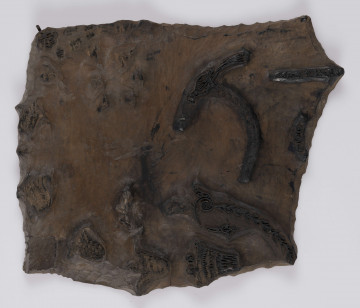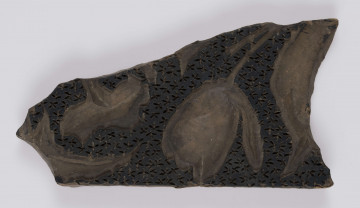
Block for printing on textile
1901 — 1950
National Museum in Lublin
Part of the collection: Fabric printing matrices
Textile printing is an old technique for decorating fabrics, well-known in many parts of the world. The first tools for textile printing were very simple. People made stamps with uncomplicated patterns from easily accessible raw materials such as wood or a potato. Over time, printing blocks with increasingly detailed and elaborate patterns were developed. Stamps for textile printing were often made of two boards: an ornament was engraved in a hard and resistant type of wood on one board, and in a softer and lighter type of wood hollows were carved which served as a handle, and the two boards were joined together. Thanks to this solution the entire tool was relatively light. Printing blocks could have various shapes, depending on their purpose. The most common were square-shaped forms, which were used to cover large areas of fabric. Corners were decorated with quarter-circle shaped blocks. Narrow, rectangular blocks were used to print the edges of the fabric. An example of such a form is a stamp from the ethnographic collection of the National Museum in Szczecin with a floral and geometric ornament, made entirely in wood using woodcarving technique. The pattern consists of two rosettes made of small twigs, arranged alternately with two groups of five-petalled flowers. The pattern is completed by a row of triangles running along one of the longer sides. Such a combination of floral and geometric motifs was common on printing blocks. The stamp comes from the collection of the Pommersches Landesmuseum Stettin.
Author / creator
Dimensions
cały obiekt: height: 5,9 cm, width: 28,8 cm
Object type
matrix
Creation time / dating
Creation / finding place
Identification number
Location / status

1901 — 1950
National Museum in Lublin

1901 — 1950
National Museum in Lublin

1901 — 1950
National Museum in Lublin
DISCOVER this TOPIC
National Museum in Szczecin
DISCOVER this PATH
Educational path